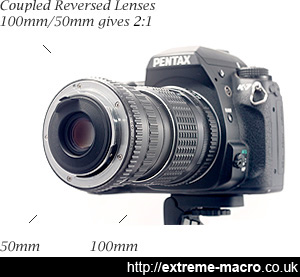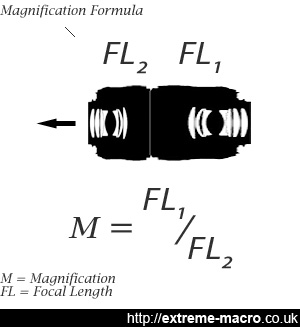Coupling Lenses For Macro
by Johan J Ingles-Le Nobel
Last updated August 31, 2017
A coupled reversed lens, also known as macro stacking or coupling lenses, is a great way to get to more extreme macro magnifications such as 4:1 - a nice way to do macro without a macro lens.

A coupled reversed lens, also known as macro lens stacking or coupling lenses. Many regular macro shooters will have lenses of these lengths already so you may not even need any other purchases other than a reversing ring to try out extreme macro. Makes for quite a bulky setup though.
Compared to the other reversed lens technique of a single reverse lens, it requires a different adapter - a coupling ring, rather than a reverse adapter, but stacking lenses like this generally gives better image quality than a single lens reversed on its own.
Coupling Ring
A macro coupling ring has male filter threads on both sides, so you can stack one lens onto another - facing each other.
The trick is to find a macro coupling ring that goes between sizes - normally they have the same size threads on each side.
If you want to couple between lenses with different threads you will also need the appropriate step-up or step-down filter adapters.
Image Quality, Stacked Vs. Single Reverse Lens
An obvious question to ask is which gives the better image quality: macro stacked lenses or a single reverse lens on bellows.
The answer is in fact a stacked pair: single reversed lenses can go soft in the corners because of field curvature, but in the centre there is not a noticeable difference.
Obviously the main relay lens needs to be of decent quality otherwise this can let the joined lens arrangement down, but there is compelling evidence to support the view that coupling one lens to another can make for spectacular quality for certain magnifications. On top of that, for a given magnification, coupled lenses do have a lower effective aperture than lenses on extension. The difference is significant at very low m, not so much at m > 3.
Stacked Lens Magnification

Magnification formula for reversed lens.
With a lens stacked onto another lens the formula is simple: divide the main lens mm by the reversed lens mm. In other words, a 50 reversed onto a 100 lens would give you 2:1.
For lenses reversed on their own, there is no such formula, and often the best way to find out is simply to take an image of a ruler and, knowing the size of your sensor, divide it by the size of ruler on image. Ie, if you shoot Pentax APSC but you can see only 6mm of rules across in the image with a reversed lens you know you're at about 4:1 (23.6/6).
Stopping Down
You will find that you get higher image quality by stopping down the front lens (the reversed one) and leaving the other one wide open (to act as a tube 'gathering' lens).
The best f-stop is best determined by experiment; too wide open and the image will go soft from aberrations, too far closed and it'll go soft from diffraction. There should be a sweet spot which is a compromise between the two.
If you use the non-reversed lens aperture rather than the reversed one it will let through a lot of optical aberrations because it's far away from the 'optical centre' of the combined lens. The centre of the combined lens is actually still for all intents and purposes physically the centre of the reversed lens - the non-reversed lens is just acting as a tube lens. You start getting quite nasty and strange image aberrations when you move the aperture away from the optical centre, so use the front (reversed) one for aperture alterations and just leave the other one wide open.
Vignetting
Stacking lenses for macro gives better image quality than a single lens reversed on its ownThe amount of vignetting that you may or may not see when stacking lenses for extreme macro has various factors, including the focal length of and the f/stops used in both lenses. Extension tubes or bellows can help avoid vignetting but in a sense it is a false avoidance because actually you're just adding magnification so magnifying the non-vignetted part of the image circle.
If you have vignetting on your reversed lens, make sure that your lenses are wide open and the rear is focused at infinity. It maybe that your lens combo isn't fast enough and you still have vignetting, in which case try increasing the magnification (ie magnify the non-vignetted part) by using tubes, bellows etc.
Use a Macro Lens?
You maybe tempted to try using a macro lens as the rear lens (ie the longer one), but be aware that this is not neccessarily a route to success. Macro lenses tend to have the front element recessed into the body of the lens, and you really want the front element as close to the reversed lens as possible. And with macro zoom lenses as the rear lens, the front pupil might be too far back. Both of these will lead to vignetting.
Make A Lens Hood
a macro coupling ring has male filter threads on both sidesThe performance of older manual lenses can be improved by making a custom hood. There are all sorts of ways to do this but I found that an old soft plastic end cap with an appropriate hole cut into it makes for a great hood. A hood increases contrast.
Protecting The Reversed Lens
Once mounted in reverse, you will see some of the mechanics of your lens that are normally not exposed. All of the pins the lens uses to talk with the camera are visible as well as the internal glass element that moves in and out when focusing.
Leaving a lens on in reverse can let dust inside your lens so I use the end cap that came with the lens as a lenscap. Cheap, fits, and works perfectly.
Related Articles





